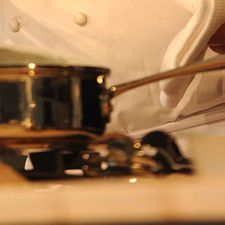Violinist David Garrett, photo CC by Dove Bongartz via Wikimedia Commons
Classical isn’t dead and stop comparing it to pop already
Slate’s Mark Vanhoenacker published a statistics-laden (and admittedly sympathetic) “requiem” on the death of classical music last week. True, if you look at classical music through the lens of pop music, you might be forgiven for seeing a ER patient gasping for breath on a Beyonce-embossed hospital bed. But it’s been a long time since classical and pop music have competed for the same prizes, and that’s the problem with his argument: Vanhoenacker fundamentally misunderstands what classical music is about in the 21st century. Classical isn’t the same cultural beast as pop—not anymore anyway. It might not ever be again, and that doesn’t matter in the least for its survival.
Paradoxically, Vanhoenacker manages to tip the hand for what’s actually going on, though he fails to connect the dots. In his closing paragraph, he states, “Myself, I cling to the forlorn hope that classical music has been down for so long, it must somehow be due for a comeback.” Who knows, maybe a surge in popularity is actually just around the bend. But what we have today, right now, is a sizeable minority of people who passionately care about classical music—Vanhoenacker included—and who wring their hands very vocally over pop-colored assessments that seemingly attack the art they cherish. That speaks to a certain type of cultural phenomenon, one fundamentally at odds with the metrics of the commercial music industry.
Reflect for a moment: Why don’t indie rockers mope around the table lamenting the demise of grunge, or hair metal, or new wave? Because pop music fulfills certain societal functions, and when one genre goes out of style another bursts into the collective conscious to take its place. We can still shake our booties in the club, rock out behind the wheel on the way to the office, impress our friends with how obscure our musical tastes are, and stare at the computer screen late into the night, enveloped by deadlines and headphones. Pop music reinvents itself to meet all these needs and more.
Classical music doesn’t have these same functions, but it has others, and there is literally no replacement for what it offers. That’s why its proponents are so passionate. Now don’t get me wrong—I’m not making some kind of highbrow/lowbrow argument here. It’s just that the cultural processes that led to classical music are unique to human history, and so are the ways we use the artform. There is no other tradition that glorifies the composer’s role to the extent of classical music. There is no other tradition where documented performance practice reaches back almost 1000 years. There are few other traditions that consistently makes such extreme technical demands of its performers (maybe Indian classical music). And there is only one other genre that routinely inspires its listeners to seek out different interpretations of the same piece (jazz).
This is not to say there’s no art in other kinds of music, but the kind of art that classical music makes possible scratches a very particular cultural itch—an itch that seems to have remarkable staying power. As I’ve argued before, trying to compete with the pop industry is a waste of time. The successes of classical music stem from emphasizing what makes it different. Over the past 120 years, classical music has reinvented itself to survive within the technological revolutions of recording, broadcasting, and online streaming. How, where, and why we use music has completely changed since the 1890s and entire genres have evolved to meet the new musical reality, yet classical stands fiercely against these shifting cultural headwinds. It continues to attract a small but passionate following of people who appreciate the unique things it can contribute, and it also continues to attract an outsized share of music philanthropy. While we may never again see an age where every major city has a thriving orchestra and opera company, classical music will continue to fill the niches that only it can. So without further ado, I will reinterpret every storm cloud from Vanhoenacker’s article to draw out the silver linings.
1. Only 2.8% of albums sold in 2013 were classical, trailed only by jazz.
I’m a classical composer, but I don’t often listen to classical music albums. Why? Because classical music doesn’t do well on recording—I would rather go see it in concert. Recorded music is almost always tied to some other activity: it is background music, driving music, party music, working music, working out music, etc etc. Few people (other than pimply-faced, love-lorn teenagers) sit around listening to albums end to end. That hasn’t always been true. When recorded music was first invented, there was less difference between how people used records and how they used live music, because they didn’t have any other model for how to listen to music. Over time, however, that has changed. We now have a sophisticated model for using recorded music in many aspects of our lives, and we’ve designed music (i.e. pop) specifically for each purpose.
Instead of asking what proportion of album sales in 2013 were classical, we should ask what proportion of album sales were of live concert recordings. That would be a better metric for classical music album sales, because by and large all classical music is designed for focused, uninterrupted listening—a model that nowadays more or less only exists for live music. Have you ever gone to see a band whose album you liked, only to find that the live show was boring and flat? Of course. Pop music is designed for the recording studio, and it usually changes considerably—or it fails miserably—when done live. That is also why the role of the music producer is so glorified in certain pop genres. Classical music on the other hand is designed for live performance, and though there are good recordings, we just don’t have a mass culture of people sitting down in soundproofed rooms to compare Karajan’s Beethoven recordings with Szell’s. Recordings to classical are what concert t-shirts are to pop: nice extras that you might use occasionally but that are tangential to enjoying the music.
2. One of the last classical radio stations, KDB, has switched to news, while Sirius XM’s classical channel is less popular than its Pearl Jam channel.
The same point about the role of recorded music holds true here. In the 1920s, people used to sit around the radio communally, but that function has long since been usurped by TV. What is the primary use of radio today? Entertainment when you’re driving. Cars are loud. Classical music has a large dynamic range. Unless you have a very expensive car, you’re not going to enjoy listening to classical music on the road.
Even if everyone did still crowd around the radio family-style in 2014, classical music wouldn’t be what they’d listen to. Radio initially evolved around the three-minute song model due to technological constraints, but that limitation proved to be an asset. Shorter durations make radio more useful: if you don’t want to hear one piece of music, then another will come on in a few minutes. By contrast, if the classical station is playing Beethoven’s 9th and you really wanted to hear a 20th-century string quartet, you’re in for a long wait—just to see if maybe the next thing will suit your tastes. Radio has never been very useful as a tool for listening to classical music.
3. Classical music has seen steadily declining attendance figures.
Vanhoenacker makes several claims about declining attendance at classical music concerts but he never offers comparative figures in other genres of music, so we only get half the picture. There may be fewer people going to symphony concerts, and younger listeners may not be “maturing” into classical music fans at the same rate they used to. However, I also don’t feel it’s much of a stretch to presume that people in their 50s and 60s go to fewer stadium and nightclub concerts than people in their 20s and 30s.
In other words, I’m doubtful that attendance at music events is a zero-sum game where attention siphoned away from classical concerts is being taken up by other genres. We live at a time that does not particularly value live music as an artform, so I suspect that the decline in classical concert attendance is a reflection of the general tendency for people nowadays to go to fewer live music events—especially as they get older. Beyond college age, attending a live concert has become a special occasion in the way eating out at a restaurant was a couple of generations ago: something you do a few times a year, when there’s an event that especially piques your interest.
Yet even so, Vanhoenacker states that 8.8% of adults attend at least one classical concert per year. That’s down from 13% in 1982, but you know what else has changed since that time? The range of entertainment options within one’s own home. They didn’t have CDs and VCR recorders in 1982—let alone Netflix and Spotify and 100s of cable channels. I would be very surprised if attendance at pop music concerts had not seen a similar decline over the same 30 years. And besides, a little less than 1 in 10 adults are still attending one or more classical concerts every year. That’s a lot of people choosing to listen to classical music, despite the increase in entertainment options.
4. The number of people who practice an instrument has fallen from 4.2% in 1992 to 2% in 2012.
Last I checked, you needed an instrument to play most styles of music. The fact that instrumental practice is declining speaks to larger trends in how we spend our free time, but it has no direct relationship to classical music’s success or failure. If anything, it reinforces my point about concert attendance becoming a “special occasion” activity. Decreased instrumental practice simply makes people less attuned to music overall; it’s not genre-specific. And on the flip side, there are a lot more people remixing their own music now than in 1992, whether via DJing or Garageband or YouTube. That’s still creative music making, it just doesn’t rely on a traditional instrument. I’d be curious to know what proportion of instrumental practice has been taken up by these newer forms.
5. The last TIME Magazine cover featuring a musician was in 1986: “Today the notion that a pianist could culturally sideline a story about aircraft carriers sounds nothing short of quaint.”
TIME didn’t replace their classical music covers with equal numbers of pop music covers, it’s just that music is not as cover-worthy as it used to be. This speaks to shifting cultural priorities, but it doesn’t tell us anything about whether or not classical music is going extinct.
6. Sitcoms use classical music as a cliché.
Clichés work because they’re oversimplifications, and that’s why they’re funny. Embedded in the “classical music is boring” joke is the understanding that there are a lot of people who do still enjoy the music. If that weren’t true, the punchline wouldn’t work.
7. Proposals to tax the NFL to fund symphonies haven’t gained traction.
Pro sports seem to have become the societal live performance of choice for our age. Maybe people flock to football games instead of symphony concerts because sporting is less ubiquitous in everyday life. You can’t leave your home without being bombarded by background music, and that makes all musical experiences less special. On the other hand, you still have to make some effort to see sports: turn on the TV, go to a sports bar, open up the sports pages, buy tickets to a game. If we replaced the background music in our public spaces with background sports, maybe people would head back to the symphony.



